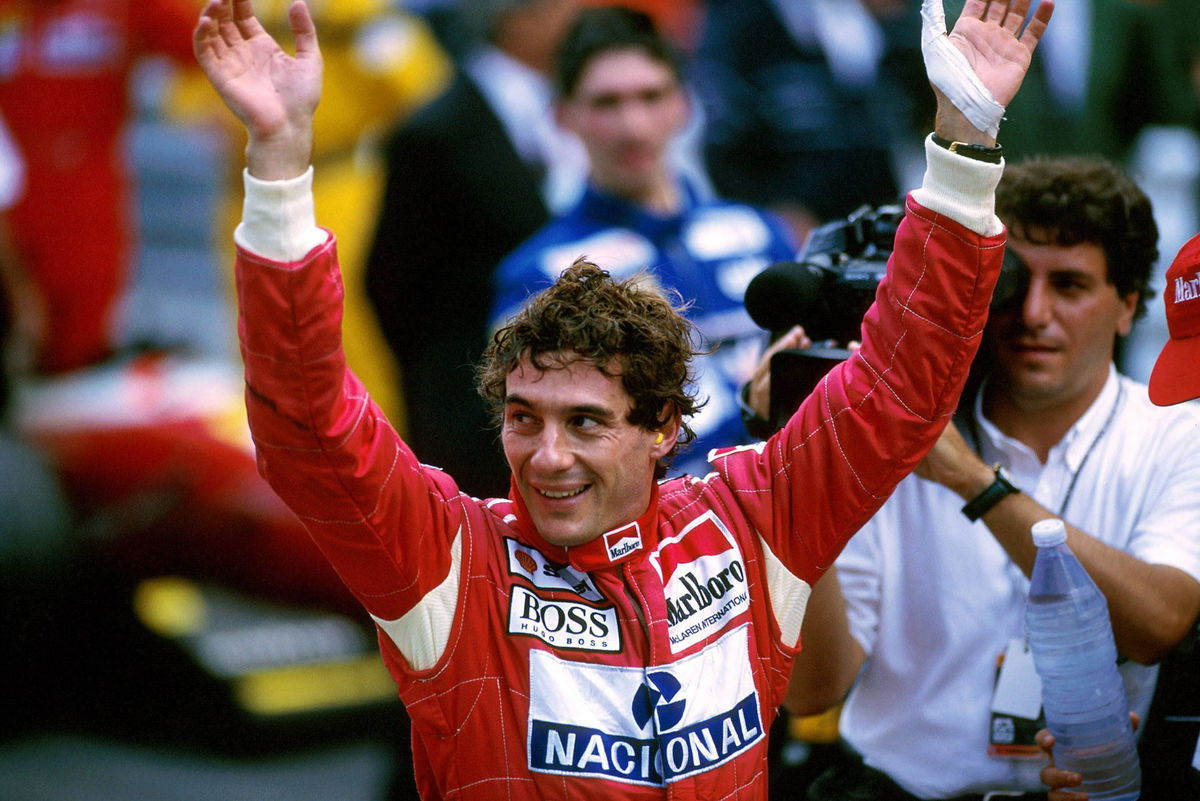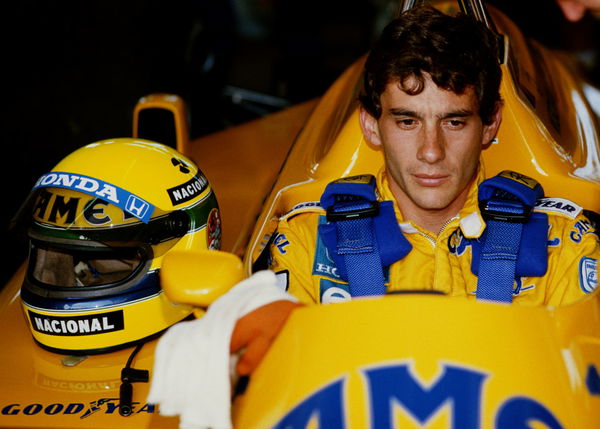
Imago
Siegerehrung nach dem GP von Monaco 1993: Sieger Ayrton Senna Brasilien / McLaren Ford Cosworth jubelt den Anhängern zu

Imago
Siegerehrung nach dem GP von Monaco 1993: Sieger Ayrton Senna Brasilien / McLaren Ford Cosworth jubelt den Anhängern zu
“If you no longer go for a gap that exists, you are no longer a racing driver”, this is a quote that is so legendary that racers to this day use it to justify their on-track shenanigans. But the man behind it was nothing less than a legend himself. The amount of cultural impact and raw emotion that Ayrton Senna invoked, not just for the Brazilian tifosi, but for the world, can hardly be matched by any driver on the grid today. Heading into the 1993 season, Senna was already a seasoned driver, considered to be one of the greatest by many.
Watch What’s Trending Now!
He scored his first title after joining McLaren in 88’, but as the greatest rivalry in the history of the sport began to take shape between Senna and Prost, the next two would not come so easy. In 1992, the Brazilian only managed to finish fourth in the championship. Driven by the desire to win, the Brazilian was looking to hunt down Prost in his Williams next season. Although Senna finished second behind Prost’s significantly overpowered Williams, he would have his crowning moment at the 93’ Brazilian GP.
ADVERTISEMENT
Ayrton Senna performs one last dance at Interlagos
Ayrton Senna’s relationship with Mclaren was past its glory in 93. So when he tried to make a move to Williams, it was his former teammate and rival, Alain Prost, who locked him out of the seat, raising tensions further. It left Senna with just two options; Ferrari, who were struggling themselves, or sticking with the team that once gave wings to his dreams. The Brazilian decided to stick with Ron Dennis’ side but at an immense price tag of 1M per race! Back in those days, that was an incredible amount. Meaning the team did anything and everything to keep the three-time champion fighting for them.

Getty
Ayrton Senna of Brazil sits aboard the #12 Camel Team Lotus Honda Lotus 99T Honda RA166E V6 turbo during practice for the Brazilian Grand Prix on 11th April 1987 at the Autodromo Internacional Nelson Piquet Jacarepagua circuit near Rio de Janeiro, Brazil. (Photo by Simon Bruty/Getty Images)
However, Mclaren’s lackluster performance was testing the Brazilian’s patience, and when his home Grand Prix came around, tensions were at an all-time high. The team was not even sure if Senna would show up to qualify! Thankfully, he did, and set a blistering fast lap that placed him third, in front of a much better performing Benetton driven by future star Michael Schumacher.
ADVERTISEMENT
The pressure was on for race day at Interlagos. Not only because of Senna’s handicap against the Williams, but it was the three-time champion’s home circuit. A circuit which he had only had the pleasure of winning once previously. The importance this circuit holds for Brazilian drivers was reflected on by former Ferrari man, Felipe Massa, earlier this year. The fire to win in front of his home crowd was burning brightly inside Senna’s heart, but his mind could only think of the issues the MP4/8 would have to conquer to have a realistic shot at winning. But the stars would align for Senna that day.
Top Stories
Max Verstappen’s Siblings: Everything We Know About Victoria, Blue Jaye, Jason Jaxx, and Mila Faye

Who Is Flavy Barla? – Esteban Ocon’s New Girlfriend After His Breakup With Elena Berri

Who Is Oscar Piastri’s Father, Chris Piastri? Co-Founder of Multibillion Dollar Automotive Company

Best Buds Lando Norris & DJ Martin Garrix Embrace Snowy French Adventure in F1 Winter Break

Lewis Hamilton & Ferrari May Be Favorites to Sign Adrian as Newey’s Wife Set to Play a Huge Role in His F1 Future

The Brazilian leapfrogged the grid and was in a comfortable second place when he was hit with a stop-go penalty halfway through the race for lapping backmarkers under yellow flags. But this adversity just fuelled Senna, resulting in one of the finest recoveries in all of Formula 1. The Brazilian was on the charge when the weather gods gave him a helping hand. With the skies getting darker and water droplets impacting the hot tarmac, the grid began to jump into pits to switch to wet tires. Unfortunately for Alain Prost, Willaims’ decision to keep him out proved costly.
ADVERTISEMENT
With his main challenger out of the way and the storm subsiding, Ayrton Senna set his sights on Damon Hill, who was leading the pack in the remaining Williams car. Playing true to the title of rain master that the media would give him, Senna made a crucial decision to undercut Hill’s Williams for the switch to dry tires. The strategy worked out in the Brazilian’s favor, allowing him to slingshot past Damon Hill as he exited the pits. The rest was history, as Senna would go on to flawlessly bring the car home to a crowd bursting with joy.
ADVERTISEMENT
Through the highs and lows – Senna was a man of the Brazilian people
Reflecting on the race, Senna’s team manager and close aide, Jo Ramirez, was quoted by motorsport.com. He looked back on the Brazilian crowd’s energy after Senna crossed the checkered line. “It was electric, the Brazilian Tifosi, with the way they celebrate, are some of the best in the world,” he says. “It was one of those races, with a little bit of rain in the air, the atmosphere was perfect.” In a season filled with ups and downs for McLaren, Ayrton Senna proved to the grid that It was not the car, but the driver.
ADVERTISEMENT
“Of course, Juan Manuel Fangio was there to give him the trophy, that made it very special.” – If there’s anything that could top the Brazilian fan’s support for Senna, it would have been the fact that the most decorated driver of the time, Juan Manuel Fangio, presented Senna with the honors. Ramirez reflected on Senna’s admiration for Fangio. “Ayrton never had any heroes except for Fangio, and Fangio said he saw himself in Ayrton. They got on really well.“
Unfortunately, the world of motorsport would lose one of its brightest stars in 1994. Senna had finally made the move to Williams in pursuit of another championship, but fate would have it otherwise. Before he could get familiar with the British team, Senna would suffer a fatal crash at the 94’ Imola GP, owing to the Williams’ aerodynamic faults that year caused by a change in suspension dynamics.
ADVERTISEMENT
WATCH THIS STORY: $300,000 McLaren Legacy Dedicated to Ayrton Senna Craned into $39,000,000 Penthouse
The sheer scale of his funeral procession echoed the impact of Senna on the Brazilian community, with the entire world paying homage to arguably the most talented Formula 1 racer of all time. A name that still inspires millions worldwide, Senna’s legacy continues to live on through the Instituto Ayrton Senna, an NGO working towards human development in Brazil.
ADVERTISEMENT
ADVERTISEMENT
ADVERTISEMENT

